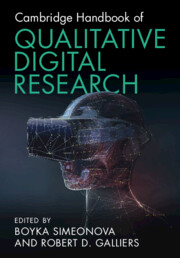Book contents
- Cambridge Handbook of Qualitative Digital Research
- Cambridge Handbook of Qualitative Digital Research
- Copyright page
- Contents
- Figures
- Tables
- Contributors
- Preface
- Part I Philosophical, Epistemological and Theoretical Considerations
- Chapter 1 Introduction
- Chapter 2 A Philosophical Perspective on Qualitative Research in the Age of Digitalization
- Chapter 3 Data as a Contingent Performance and the Limitations of Big Data
- Chapter 4 Big Data, Little Understanding
- Chapter 5 Power, Knowledge and Digitalization
- Chapter 6 Information Technology and Power
- Part II Methodological Considerations
- Part III Illustrative Examples and Emergent Issues
- Index
- References
Chapter 2 - A Philosophical Perspective on Qualitative Research in the Age of Digitalization
from Part I - Philosophical, Epistemological and Theoretical Considerations
Published online by Cambridge University Press: 08 June 2023
- Cambridge Handbook of Qualitative Digital Research
- Cambridge Handbook of Qualitative Digital Research
- Copyright page
- Contents
- Figures
- Tables
- Contributors
- Preface
- Part I Philosophical, Epistemological and Theoretical Considerations
- Chapter 1 Introduction
- Chapter 2 A Philosophical Perspective on Qualitative Research in the Age of Digitalization
- Chapter 3 Data as a Contingent Performance and the Limitations of Big Data
- Chapter 4 Big Data, Little Understanding
- Chapter 5 Power, Knowledge and Digitalization
- Chapter 6 Information Technology and Power
- Part II Methodological Considerations
- Part III Illustrative Examples and Emergent Issues
- Index
- References
Summary
The digitalization of business organizations and of society in general has opened up the possibility of researching behaviours using large volumes of digital traces and electronic texts that capture behaviours and attitudes in a broad range of natural settings. How is the availability of such data changing the nature of qualitative, specifically interpretive, research and are computational approaches becoming the essence of such research? This chapter briefly examines this issue by considering the potential impacts of digital data on key themes associated with research, those of induction, deduction and meaning. It highlights some of the ‘nascent myths’ associated with the digitalization of qualitative research. The chapter concludes that while the changes in the nature of data present exciting opportunities for qualitative, interpretive researchers to engage with computational approaches in the form of mixed-methods studies, it is not believed they will become the sine qua non of qualitative information systems research in the foreseeable future.
Keywords
- Type
- Chapter
- Information
- Cambridge Handbook of Qualitative Digital Research , pp. 15 - 27Publisher: Cambridge University PressPrint publication year: 2023



